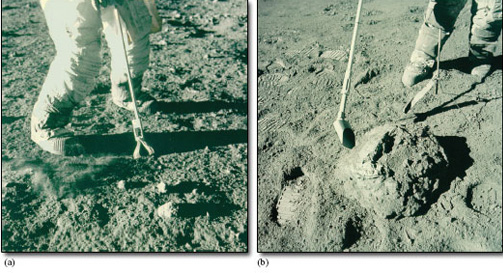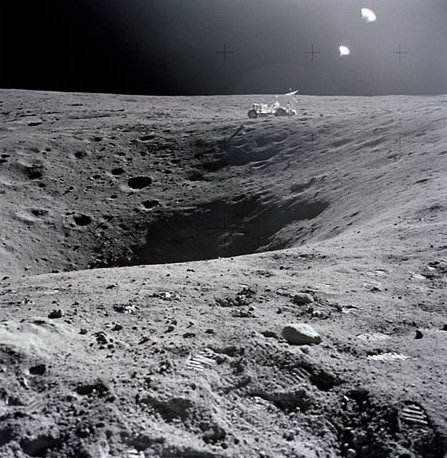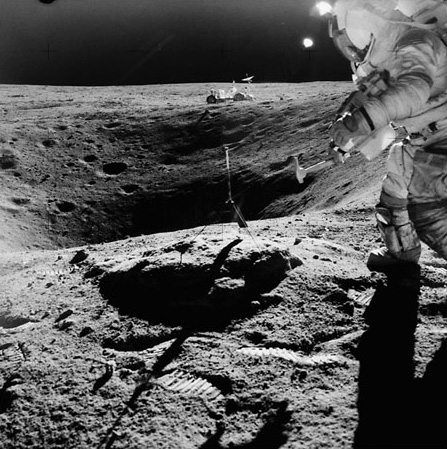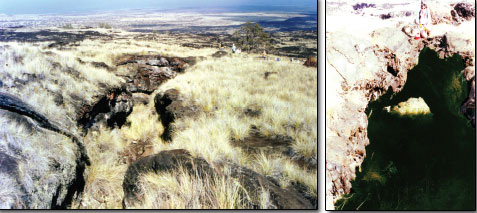3 Discussion of Chapter 6
3.1 Comments and explanations
Read the following comments and explanations before answering the questions in the rest of the course (on this page and Section 3.14).
As is the convention for satellites, the Moon's rotation period is defined in the Planetary facts table relative to the planet that it orbits rather than relative to the universe as a whole. This is a different convention from the one adopted for planets themselves.
The Moon's synchronous rotation enables the line of zero longitude to be defined on a logical principle, in contrast to the arbitrary basis used on the terrestrial planets. Lunar zero longitude is defined as running centrally across the Moon's Earth-facing hemisphere. The same principle is used to define zero longitude on synchronously-rotating satellites of other planets.
Section 2.2 mentions Kepler's second law of planetary motion in connection with the Moon's orbit round the Earth. Although originally formulated to describe the motion of a planet about the Sun, Kepler's laws also describe the motion of a satellite around any other body. Beware though that you cannot use Kepler's third law to relate orbital periods of bodies that do not orbit the same central body, because the orbital period depends on the mass of the central body.
The evidence for ice near the lunar poles is stronger than that for ice on Mercury, where we have only radar reflections using signals transmitted from the Earth. For the Moon there are two sorts of useful data, both of which were collected from lunar orbit: radar reflections detected by Clementine over the south pole (Section 2.4), and the neutron signature detected by Lunar Prospector over both poles (also Section 2.4). You are not expected to understand how the neutron signature is derived, or why it indicates ice. You can see the specific locations where Clementine indicated ice in Figure 1.
In case you were wondering, maria (meaning 'seas', and used only for regions on the Moon) is not pronounced like the girl's name. You should say 'MAH-ree-a'. The singular, mare, should be pronounced 'MAH-ray'.
Section 2.6 points out that almost all the lunar surface is covered by a layer of fragmental material (regolith) resulting from meteorite impacts. Figure 3 does not give a terribly clear impression of this, so take a look at Figure 7 below. The variety of fragment sizes is apparent, as well as the ability of the regolith to retain the imprint of a booted foot. You can also gain a good insight into what it is like on the lunar surface by looking at the panoramas that are provided as Moon34-45 below.

Figures in Chapter 6 illustrate lunar craters as small as the 300 m Elbow crater in the top right part of Figure 6. Figure 8 below shows a 40 m crater named Plum. Younger craters less than a metre across are clearly visible where sunlight falls at a grazing angle onto the inner slope of Plum in Figures 9 and 10.



It was once widely assumed that lunar craters are a result of past volcanic activity. This concept was well and truly debunked from the 1960s onwards by new understanding of the impact process, and by recognition of impact craters on all ancient surfaces in the Solar System and at all scales. In fact, very few recognisable craters on the Moon are volcanic.
Section 2.6 describes long, winding valleys interpreted as collapsed lava tubes that indicate the paths along which lava flowed to fill the mare basins, but only one example (Hadley Rille) is illustrated (Figure 6.6). This photograph is part of the panorama of Moon41. It is unlikely that the lava tube explanation for such features on the Moon would have been dreamt up, unless similar (though smaller-scale) features were already known on the Earth. Unless you are very lucky, you are unlikely to have seen one of these, so Figure 11 shows you an example.

Because their origin as lava tubes cannot often be proven, it is more usual to refer to these as rilles. There are several rilles visible in Figure 12. It is well worth examining this image, because it conveys a lot of information about lunar history.

Activity 2
How can you tell that the large crater (Prinz) in the left foreground of Figure 12 is older than the large crater beyond it (Aristarchus)?
Answer
Prinz was clearly formed before this region became covered by mare basalts. It became largely flooded by these basalt lava flows which overtopped its rim on the far side. Conversely, Aristarchus (and its associated ejecta blanket) can be seen to have been formed on top of the mare basalts. You might also note the considerable number of small impact craters on the mare surface within Prinz, whereas few or no such craters are visible within Aristarchus or on its ejecta blanket, which demonstrates that Aristarchus post-dates most of the cratering that has affected the mare surface.
